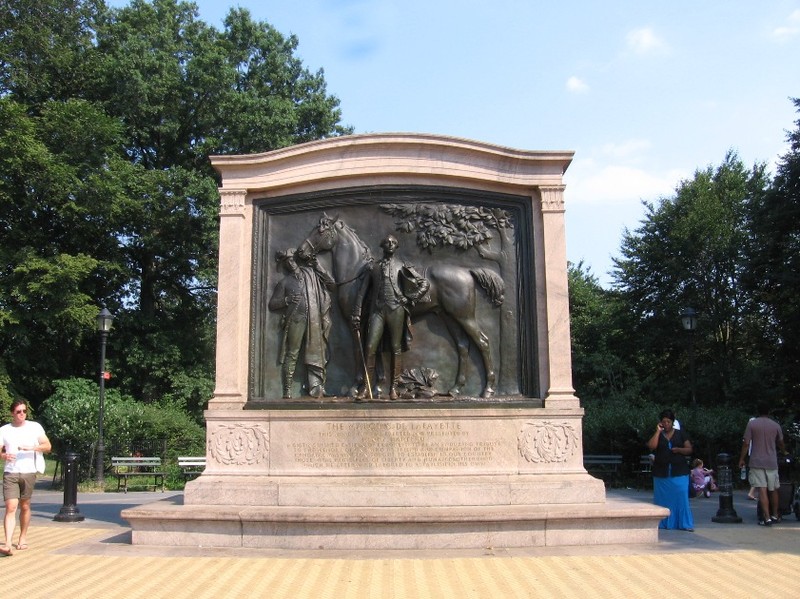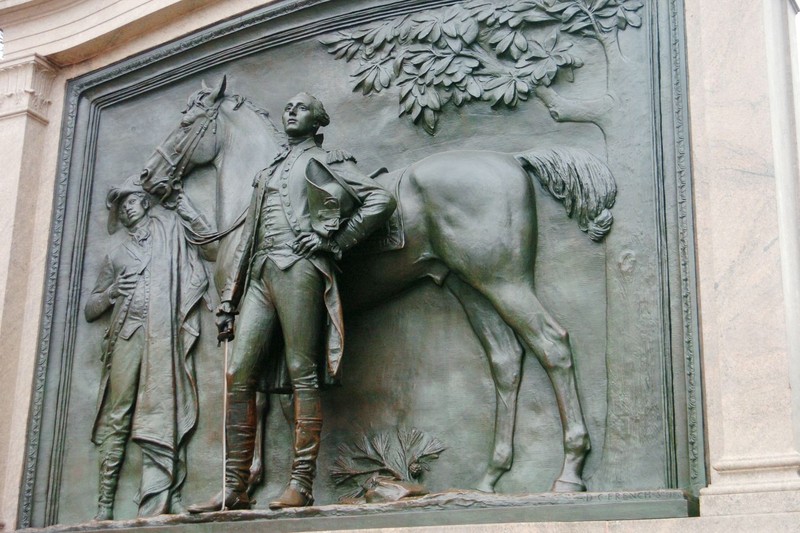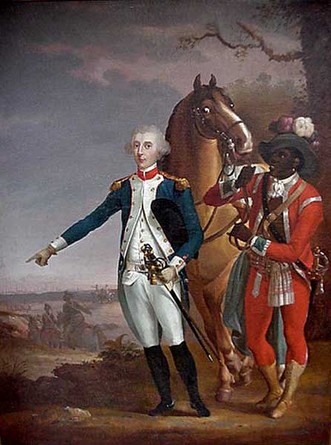Lafayette Memorial
Introduction
Text-to-speech Audio
Images
Lafayette Memorial at the 9th Street entrance to Prospect Park

A close-up of the bronze relief

Marquis de Lafayette (1757-1834)

The painting of Lafayette by Jean-Baptiste Le Paon on which the relief is based

Backstory and Context
Text-to-speech Audio
Gilbert du Motier, Marquis de Lafayette (full name: Marie-Joseph-Paul-Yves-Roch-Gilbert du Motier, Marquis de Lafayette) was born into a noble family in Chavaniac, France on September 6, 1757. His early years were marked by tragedy. Just before his second birthday, Lafayette’s father, Michel, died at the Battle of Minden during the Seven Years’ War. About ten years later, his mother passed away. Despite being orphaned at a relatively young age, Lafayette inherited one of France’s largest fortunes. In 1774, he married Adrienne de Noailles, a young woman from an even wealthier and well-connected family.
Immense wealth and elevated social status, however, did not satisfy Lafayette. Instead, he yearned for military glory. To this end, Lafayette obtained a captain’s commission in the French army and served with the Black Musketeers. Two years later, however, he lost his commission when the French government slashed military spending. That same year, Lafayette attended a dinner party in Metz. The guest of honor was the Duke of Gloucester, the younger brother of Great Britain’s King George III. During the course of the event, the Duke of Gloucester informed Lafayette of the situation in the American colonies. Inspired by the ideals of the American cause and still seeking glory on the battlefield, the young French nobleman sailed to the American colonies in early 1777.
Despite being only nineteen years of age and having no battlefield experience, Lafayette secured a commission as a major general in the Continental Army shortly after arriving in the summer of 1777. He also quickly developed a close father-son-like relationship with the commander of the army, General George Washington. Following his heroics at the Battle of Brandywine, Lafayette received his own division to command. In February 1779, he returned to his native country. With Benjamin Franklin and John Adams, Lafayette convinced French King Louis XVI to send additional military aid to the American revolutionaries. After returning to the American colonies in the spring of 1780, he took command of an army in Virginia. Lafayette incessantly harassed the British army under the command of General Charles Cornwallis, eventually trapping it at Yorktown with the help of American and French forces. After a siege that lasted about three weeks, the British general surrendered his army on October 19, 1781.
With American independence all but secured, Lafayette returned to France in 1782. Two years later, he visited the United States, during which time several states made him an honorary citizen. In 1824, President James Monroe invited Lafayette to once again visit the United States, where he received a hero’s welcome. While touring the country, he made an emotional stop at Washington’s tomb at Mount Vernon and became the first foreign citizen to address the U.S. House of Representatives. Ten years after his triumphant tour of the United States, Lafayette died in Paris. As per his request, he was buried with dirt from Bunker hill that he had collected during his 1824 visit to the United States. Nearly 180 years later, in 2002, Congress made Lafayette an honorary citizen of the United States, an honor bestowed upon only eight individuals to date.
In 1895, Henry Harteau, a wealthy French-born Brooklyn resident, died of typhoid fever. In his will, he stipulated that, following his wife’s death, $35,000 of his estate would be donated to the City of Brooklyn for the erection of a monument to his fellow countryman and personal hero, Lafayette. Harteau also requested that the monument be placed in Brooklyn’s Prospect Park. Dedicated in May 1917, the monument consists of a bronze relief set into a pink granite stele. Designed by renowned sculptor Daniel Chester French and based on a painting of Lafayette by Jean-Baptiste Le Paon, the relief depicts the French nobleman standing in military uniform with his horse and an African-American groomsman behind him. The stele was designed by distinguished architect Henry Bacon.
Sources
Klein, Christopher. "10 Things You May Not Know About Marquis de Lafayette." History. A&E Television Networks. 6 February 2020. Web. 29 January 2021 <https://www.history.com/news/10-things-you-may-not-know-about-the-marquis-de-lafayette>.
Leepson, Marc. "Marquis de Lafayette." Encyclopædia Britannica. Web. 29 January 2021 <https://www.britannica.com/biography/Marquis-de-Lafayette>.
"Marquis de Lafayette." New York City Department of Parks and Recreation. The City of New York. Web. 29 January 2021 <https://www.nycgovparks.org/parks/B073/highlights/13307>.
Stockwell, Mary. "Marquis de Lafayette." George Washington's Mount Vernon. Mount Vernon Ladies' Association. Web. 29 January 2021 <https://www.mountvernon.org/library/digitalhistory/digital-encyclopedia/article/marquis-de-lafayette/>.
http://baldpunk.com/2009/08/17/old-stone-house-and-prospect-park/
https://nymag.com/intelligencer/2016/02/invisible-black-man-on-lafayettes-statue.html
https://www.history.com/news/10-things-you-may-not-know-about-the-marquis-de-lafayette
https://commons.wikimedia.org/wiki/File:Armistead_and_Lafayette_by_Jean_Baptiste_Le_Paon_1783.jpg
